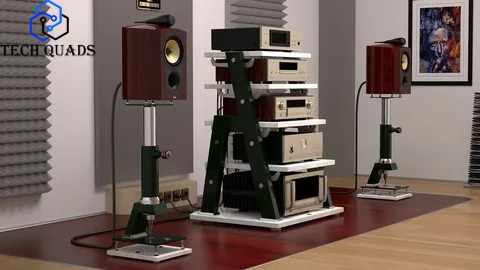Speakers are essential to any event, whether a meeting, a presentation, or an interview. No matter the occasion, having a great speaker is key to success. And one of the best ways to ensure that is by ensuring their equipment is perfect. In this blog post, we will explore speaker stands in-depth and answer some of the most common questions about them. From what type of stand to choose to how to set it up for optimum sound quality, we’ll cover it all. So don’t hesitate to ask the expert—we’ll be happy to help.
What are speaker stands?
Speaker stands are special equipment that allows speakers to be elevated, so their voices can carry farther. They come in various shapes and sizes and can be used with a microphone or without one.
There are a few things to keep in mind when using speaker stands: the height of the stand, the type of microphone, and the positioning of the stand. The height of the stand should be high enough so that it doesn’t touch your head when speaking, but not so high that it’s uncomfortable. A good rule of thumb is to raise your voice an octave or two when you use a speaker stand.
The type of microphone you use also affects how you should position your speaker stand. For example, if you’re using a condenser mic, you want to position the mic close to your mouth so that the sound quality is good. On the other hand, if you’re using an omnidirectional mic, positioning the stand far away from your mouth is usually better.
Finally, consider where to put your speaker stand. You don’t want it in front of or behind the audience; place it between these two positions.
Types of speaker stands
There are a few types of speaker stands that you might encounter.
The first type is the desktop stand. This stand is attached to a desk or countertop and holds your speakers upright. They’re great if you have a single pair of speakers or only need them for occasional use.
Another type of stand is the portable speaker stand. These stands are smaller and more compact, so they’re great for taking with you on trips or using multiple speakers at once. They tend to be more expensive than desktop stands, but they’re worth it if you frequently use multiple speakers.
Finally, we have the DJ speaker stand. These stands are specifically designed for DJs and music producers. They’re taller than portable stands and often have built-in features like turntables or effects slots. They’re more expensive than either desktop or portable stands, but they’re worth it if you use your speakers a lot for DJing or producing music.
Benefits of using speaker stands
Speaker stands are essential for any sound system and can provide many benefits.
First and foremost, speaker stands allow you to position your speakers more throughout your audio space. This can help ensure that the sound reaches all room corners and is evenly distributed. Additionally, a properly-placed speaker will produce better sound quality than one at an angle. Speaker stands also make it easy to move your speakers around should you decide to reposition them for a better listening experience.
Another big benefit of speaker stands is their ability to support heavy speakers. Many speaker stand models offer a range of capacities (from 2 to 8 kg), meaning they can handle practically any model. Not only does this make setup much easier, but it also means that your speakers will stay in place during intense shows or concerts – no more fear of them toppling over!
In addition to their practical functions, speaker stands are often beautifiers in any audio environment. Their sleek design, paired with professional-grade materials, frequently makes a noticeable difference in the look and feel of the audio space. Whether you’re looking to improve the overall aesthetics of your home theater or add a touch of class to your music collection, a set of good-quality speaker stands is likely what you need.
How to choose the right type of speaker stand for your needs
When you’re shopping for a speaker stand, there are a few factors to keep in mind. The type of sound you want to produce, the size of your speakers, and the available space all affect what kind of stand is best for you.
To produce the most powerful sound possible, you’ll want to choose a speaker stand that can handle your speakers’ weight. A tabletop stand may be ideal for smaller or more lightweight speakers. If you have larger speakers or want to mount them on the wall, an industrial-grade speaker stand is likely your best bet.
Also, consider how much space you have available. If your space is limited, pick a stand that’s easy to move around. Some stands require screws or quick-release clamps to attach the speaker to the stand; others rely on suction cups.
Finally, consider what kind of sound quality you’re after. Portable tabletop stands tend to produce better sound quality than stationary stands because they’re not as tightly packed together and don’t obstruct vibrations from the speakers as much as fixed stands do. On the other hand, stationary industrial-grade stands are often better for producing high-quality sounds because they’re built with heavy metal plates that distribute vibrations more evenly throughout the frame.
Setting up a speaker stand
Setting up a speaker stand is an important part of sound quality for any event. There are a few things to consider when setting up your speaker stands, such as the height and width of the speaker, the type of mount you’re using, and the weight of your speakers.
Here are four tips for setting up your speaker stand:
- Choose a height that’s comfortable for you and your speakers. The taller your speaker stands, the better bass response you’ll get. But make sure the height is appropriate for the size of your speakers; if they’re small or lightweight, stay within the stand.
- Pick a width that’s appropriate for your space and speakers. You want to avoid walking around with big equipment just to listen to music! A good rule of thumb is to decide twice as much width as you need.
- Select a mount that suits your speakers and space. Many mounts are available, from adjustable ones that can fit most speakers to clamp-on mounts that securely hold specific speakers in place. Consider how easy it will be to adjust the mount while playing music, so it always sounds perfect—no more frustrating wonky sound levels!
- Weight is important when setting up a speaker stand—you don’t want it to be too heavy or impossible to
Troubleshooting tips for using speaker stands
I’ve been using speaker stands for years, but I’m always looking for tips on optimizing their use.
Here are a few troubleshooting tips:
- Make sure your speakers are firmly mounted to the stands. Even if they’re not moving, vibration can cause sound distortion.
- If your speakers aren’t sitting squarely on the stand’s feet, you may experience distortion and poor sound quality. Adjust the height of your speaker until it’s at the same level as the stand’s foot (or slightly below).
- If your speakers constantly fall off the stand, tighten their screws or add weight to the bottom end.
- Be careful not to let cords dangle down from your speaker stands; they can become caught on door handles or other objects, causing them to break or tangle.









